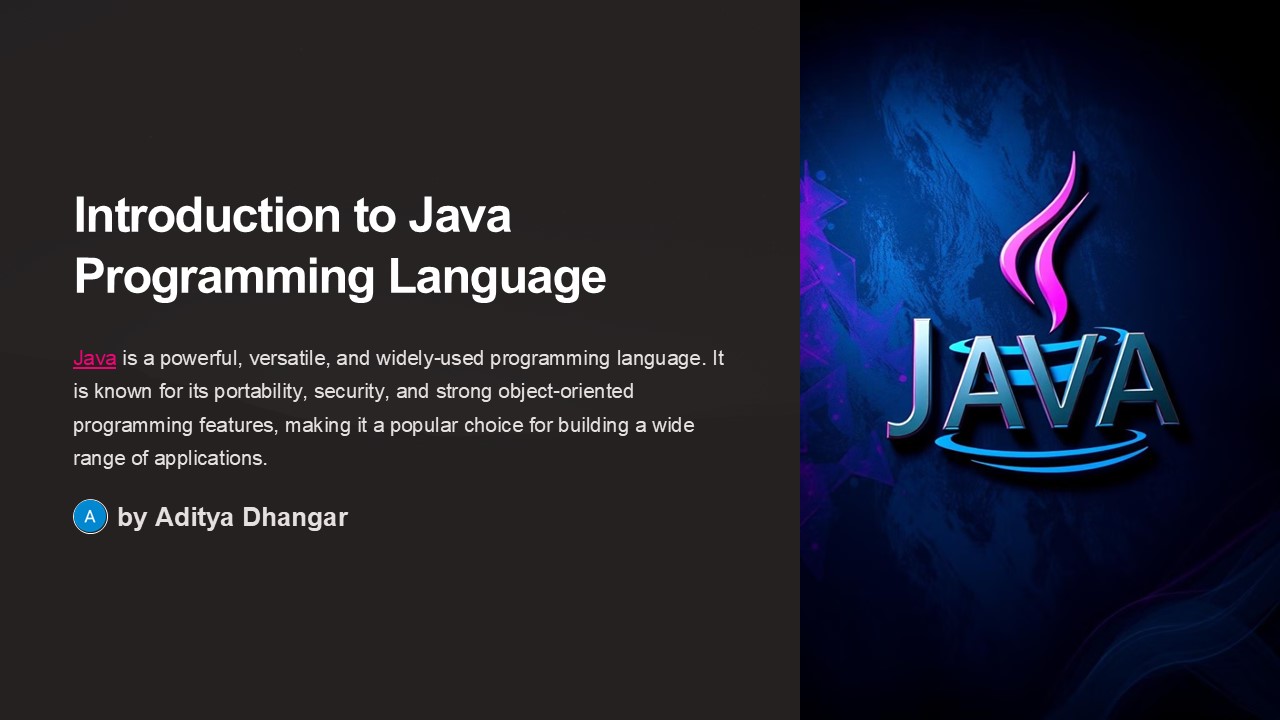Java Fundamentals: Building Blocks of Modern Software Development (1) - PowerPoint PPT Presentation
Title:
Java Fundamentals: Building Blocks of Modern Software Development (1)
Description:
This PowerPoint presentation offers a detailed and engaging introduction to Java programming, ideal for beginners, aspiring developers, and those looking to refresh their knowledge. Java is one of the most widely used programming languages in the world, known for its versatility and reliability in creating everything from mobile applications to large-scale enterprise systems. In this presentation, we will explore the core features and benefits of Java, including its platform independence, object-oriented design, and robust security features. We will dive into the basic structure of Java programs, covering essential topics such as classes, methods, variables, and the "Hello World" program. You will also learn about Java’s key concepts, including encapsulation, inheritance, polymorphism, and abstraction, which form the foundation of object-oriented programming (OOP). – PowerPoint PPT presentation
Number of Views:1
Date added: 8 November 2024
Slides: 11
Provided by:
Adityadhangardg984
Category:
How To, Education & Training
Tags:
Why and how:
Creating this Java presentation was motivated by a desire to make learning Java accessible, clear, and engaging for new learners. Java’s versatility and its role in so many industries make it an essential skill for any aspiring developer, and I wanted to demystify the language by breaking it down into easy-to-understand sections that focus on both concepts and practical applications.
Title: Java Fundamentals: Building Blocks of Modern Software Development (1)
1
Introduction to Java Programming Language
Java is a powerful, versatile, and widely-used
programming language. It is known for its
portability, security, and strong object-oriented
programming features, making it a popular choice
for building a wide range of applications.
by Aditya Dhangar
2
History and Evolution of Java
1995 Java's Inception
2004 Java 1.5 (Java 5)
Java was created by a team at Sun Microsystems,
led by James Gosling, with the goal of developing
a platform-independent language.
This major update introduced generics, enhanced
for-each loops, and other features that improved
Java's expressiveness and type safety.
1
2
3
1996 Java 1.0 Release
The first public release of Java brought features
like object-oriented programming, garbage
collection, and cross-platform portability.
3
Java Syntax and Data Types
Syntax
Data Types
Variables
Java has a C-like syntax, with curly braces,
semicolons, and strict rules for variables,
methods, and class definitions.
Java provides a range of primitive data types,
including integers, floating-point numbers,
booleans, and characters, as well as more complex
object types.
Variables in Java must be declared with a
specific data type and can be assigned different
values throughout the program's execution.
4
Control Structures and Conditional Statements
Conditional Statements
Loops
1
2
Java provides if-else statements and switch-case
statements to control the flow of execution based
on specific conditions.
Java supports various loop structures, including
for, while, and do-while loops, to repeatedly
execute a block of code.
Branching
3
The break and continue statements allow you to
exit a loop or skip an iteration, providing more
control over the flow of execution.
5
Object-Oriented Programming Concepts in Java
Classes and Objects
Inheritance
Encapsulation and Polymorphism
Java is an object-oriented language, where
classes define the structure and behavior of
objects, and objects are instances of those
classes.
Java supports inheritance, allowing classes to
extend and inherit properties and methods from
parent classes, promoting code reuse.
Java's encapsulation and polymorphism features
enable data hiding and method overriding, leading
to more modular and flexible code.
6
Java Packages and Libraries
Java Standard Library
Third-Party Libraries
The Java Standard Library provides a vast
collection of pre-built classes and interfaces,
covering a wide range of functionality, from I/O
to networking.
Java developers can leverage a rich ecosystem of
third-party libraries and frameworks, such as
Spring, Hibernate, and Apache Commons, to
accelerate development.
Package Management
Modular Design
Tools like Maven and Gradle help manage Java
project dependencies and package distributions,
streamlining the development and deployment
process.
Java's module system, introduced in Java 9,
allows for better encapsulation and scalability
by organizing code into well-defined, reusable
modules.
7
Java Applications and Use Cases
Web Development
Mobile Development
Enterprise Applications
Scientific Computing
Java is a popular choice for building robust and
scalable web applications, thanks to frameworks
like Spring and Jakarta EE.
With the introduction of Java for Android,
developers can now create mobile apps using the
familiar Java language.
Java's reliability, security, and scalability
make it a preferred language for building
large-scale enterprise systems and distributed
applications.
Java's strong mathematical and analytical
capabilities, combined with libraries like Apache
Commons Math, make it suitable for scientific
computing and data analysis.
8
Demonstration Simple Java Program
Class Definition
The program starts with a class declaration,
which serves as the fundamental building block of
Java applications.
Main Method
The main method is the entry point of the
program, where the execution begins.
Print Statement
The classic "Hello, World!" message is printed to
the console using the System.out.println() method.
9
Best Practices for Java Development
Code Formatting
Exception Handling
1
2
Adhere to Java's code style guidelines, using
consistent indentation, naming conventions, and
formatting to improve code readability.
Properly handle exceptions to ensure your
application can gracefully recover from
unexpected situations and provide helpful error
messages.
Modular Design
Unit Testing
3
4
Organize your Java code into logical modules or
packages to promote maintainability, scalability,
and reusability.
Integrate automated unit tests into your
development workflow to catch bugs early and
ensure the correctness of your code.
10
Conclusion and QA
In this presentation, we've explored the
fundamentals of Java programming, including its
history, syntax, core concepts, and a wide range
of applications. We've also discussed best
practices for Java development to help you write
clean, maintainable, and scalable code.
Now, let's open the floor to any questions you
may have about Java programming. I'll do my best
to provide clear and informative answers.































